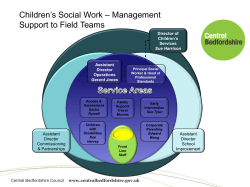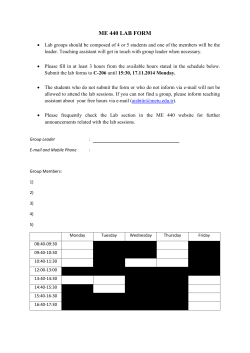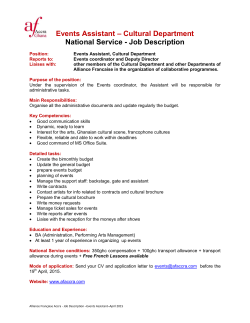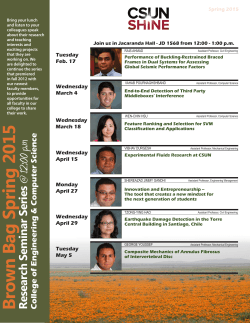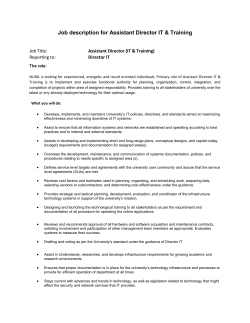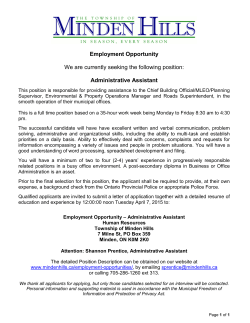
Academy Insights, Vol.6, No. 1
Academy Insights Vol. 6, No. 1 Incorporating Games into Your Teaching Adult learning concepts motivate medical educators to include as much active learning as possible during their didactic sessions. By Dara Brodsky Mungai and Jones propose that the use of games (also known as experiential learning, instructional simulations, or group learning) in an academic setting can help to enhance the learning process.1 They have developed a website Parade of Games in PowerPoint (http://facstaff.uww.edu/jonesd/games/), which provides PowerPoint templates and an example of 16 games such as Jeopardy, Idea Map, and Scavenger Hunt that can be used for medical education. The theory is that, by sparking some friendly competition, games will make learning more fun and will help your learners retain content. This teaching style is often well accepted by the current generation of learners as they have grown up with digital games. A well-constructed game requires some or all of the following components:2 Control: Provide the learners with a clear description of the game. Competency: Identify the knowledge/skill/behavior that the game is designed to improve. Conflict: Ask the learners to overcome an obstacle to achieve the goal. Closure: Specify how the game ends (e.g., specific time limit, point total). Some questions to consider when introducing a game into your teaching session are: 1,3 What is the purpose of the game? (e.g., to create the context for the learning, to reinforce specific learning content, to apply learning concepts) Is the game meant to be formative or summative? Is the game an effective way to reinforce the learning objectives? What type of game should be used? Do I have the technology required to support the game? When should the game occur? (this answer is partly dependent on its purpose; can be prior, during, or after the session) o How can the game be presented without disrupting the flow of the session? If the game is going to be played in groups, how large should the groups be? How much time should be allotted to the game? How will the game answers be provided? (e.g., group response during session, post-session email) By using a fun yet purposeful approach, including games in your teaching sessions can help reinforce content and connect concepts. 1Mungai D, Jones D. Games to teach by. Proceedings of the 18th Annual Conference on Distance Teaching and Learning. Aug 2002. 2Thiagarajan S. Ask Thiagi. Thiagi Game Letter. 1998;1(4):6. 3Salopek JJ. Stop playing games. Training and Development. 1999;53(2):29-38. Critical Thinking Interest Group The Critical Thinking Interest Group, co-chaired by Ed Krupat and Rich Schwartzstein, has continued to work on defining the elements of clinical reasoning and the relative roles of hypothetico-deductive and inductive reasoning in the approach to clinical problems. Using a publication emanating from a Millennium Conference sponsored by the Shapiro Institute at HMS and Beth Israel Deaconess Medical Center, the group reviewed milestones of critical thinking and discussed the attributes of a critical thinker, as distinct from the behaviors that exemplify the thinking process. In discussing the role of "thinking" skills in the new curriculum, the group is now contemplating the design of an "advanced science" course for the third year of the curriculum. The interest group welcomes Academy members who would like to contribute to these efforts. Analysis of Personal Statements of Residency Applicants By Dara Brodsky By using textual analysis, Ian Lancashire (an English professor at the University of Toronto) recognized signs of Alzheimer's disease in Agatha Christie when she was 81 years old because she stopped using complicated words in her 73rd novel (http://www.npr.org/templates/story/story.php?storyId =127211884). Similar to cognitive scientists, Dr. Nora Y Osman (HMS Academy member, Associate Clerkship Director, Internal Medicine Clerkship at BWH,) thinks a lot about the importance of language in medicine and how written words reflect how we think. With this interest in mind, Dr. Osman joined forces with Cheryl Schonhardt-Bailey (Professor of Political Science at the London School of Economics) and BWH colleagues to describe common themes and gender differences in the personal statements of medical students applying to the Brigham and Women's Hospital internal medicine residency program. The group analyzed 2,138 de-identified personal statements using 2 software programs that identified common words and phrases that were then categorized into themes by ensuring both internal homogeneity and external dissimilarity. Four authors then independently and blindly interpreted the findings and provided a description of each theme. The authors report 5 common themes: 1. Memorable patients: descriptions of personal experience with sick patients 2. Research and academia: descriptions of research experience and future research interests 3. Family inspirations: descriptions of sick family members or family members in the medical profession 4. Appeal of the residency program: descriptions of student's interest in the program 5. Health care as public policy: descriptions of student's desire to "make a difference" in the community Interestingly, the analysis identified gender differences with men being more likely to describe personal characteristics and emphasize self-promotion. Women were more likely to focus on the communicative and team-based qualities of being a doctor. These findings were published in Medical Education in Dec 2014 ( http://onlinelibrary.wiley.com/doi/10.1111/medu.12487/pdf). Dr. Osman notes that this analysis provides insight about "how students construct their professional identity and how they see themselves fitting into their chosen professional communities. To examine this further, Dr. Osman and her collaborators are using textual analysis to compare the personal statements of medical students applying to 5 different residency programs at BWH to examine differences and similarities among the fields. In addition, their work will examine unconscious bias and the possible implications in student education and specialty choice. Who's Who in the Harvard Medical School Academy Lawrence C. Tsen, MD Lawrence Tsen, MD is an Associate Professor in Anaesthesia, Harvard Medical School, the Associate Director for the Center for Professionalism and Peer Support, Brigham and Women's Hospital, and Vice Chair, Department of Anesthesiology, Perioperative, and Pain Medicine, Brigham & Women's Hospital. An author of over 140 peer-reviewed articles and chapters, Dr. Tsen conducts clinical and basic science investigations focused on the impact of anesthesia on maternal and fetal outcomes; he has served as Chair for the BWH Panel of the Partners Human Research Committee/Institutional Review Board for the past 12 years, and has been the recipient of a number of research and teaching awards. A recent President for the Society for Obstetric Anesthesia and Perinatology and Editor-in-Chief for the International Journal of Obstetric Anesthesia, Dr. Tsen serves as an editor for the textbook Chestnut's Obstetric Anesthesia: Principles and Practices and as a member of a number of national and international Research Grant Review Boards. A Midwesterner, Dr. Tsen graduated from the University of Kansas School of Medicine, studied at the New England Conservatory, and completed his residency in anesthesia at Michael Reese Hospital and his fellowship in obstetric anesthesia at the Brigham and Women's Hospital. Dr. Tsen is married to a Labor and Delivery nurse, and his favorite works in progress are their three children and playing jazz piano whenever he can. Ole-Petter Hamnvik , M.B.,Ch.B. OP Hamnvik graduated from the Royal College of Surgeons in Ireland in 2005. After two years of residency at Beaumont Hospital in Dublin, he moved across the Atlantic in 2007 to complete his internal medicine residency and endocrine fellowship at BWH. His interest in medical education dates back to his role as an Associate Tutor for the clerkship students at his hospital in Ireland. At BWH, he has continued to cultivate this interest as a Chief Medical Resident at BWH in 2012-2013 and as a Rabkin Fellow in Medical Education in 2014-2015. He is currently the associate program director for the BWH Endocrinology Fellowship and an assistant program director for the BWH Internal Medicine Residency Program. From an educational standpoint, he is interested in training program administration and in the development of online learning programs. Clinically, he sees general endocrine patients with a particular interest in patients with endocrine disease in the cancer patient. When he is not working, he likes to cook and hike and find time to play with his son, Jasper. Congratulations to the following Academy members on Academic promotions during 2014! Vanesa Bijol, M.D. Assistant Professor of Pathology Colleen Monaghan, M.D. Assistant Professor of Medicine Muthoka Mutinga, M.D. Assistant Professor of Medicine Nora Osman, M.D. Assistant Professor of Medicine Jeremy Richards, M.D. M.A. Assistant Professor of Medicine Ronald Arellano, M.D. Associate Professor of Radiology James Gordon, M.D. Professor of Emergency Medicine Rebecca Minehart, M.D. Assistant Professor of Anaesthesia May Pian-Smith, M.D. Associate Professor of Anaesthesia Subha Ramani, M.D. Assistant Professor of Medicine Patrick Lee, M.D. Assistant Professor of Medicine Katherine Miller, M.D. Assistant Professor of Population Medicine Fidencio Saldana, M.D. Assistant Professor of Medicine Leigh Simmons, M.D. Assistant Professor of Medicine Clyde Lanford Smith, M.D., MHP Assistant Professor of Medicine Katharyn Atkins, M.D. Assistant Professor of Obstetrics, Gynecology and Reproductive Biology Rebecca Berman, M.D. Assistant Professor of Medicine Kitty O'Hare, M.D. Assistant Professor of Medicine Roy Phitayakorn, M.D., MHPE Assistant Professor of Surgery Gyorgy Baffy, M.D., Ph.D. Associate Professor of Medicine David Brown, M.D. Associate Professor of Pediatrics Barbara Cockrill, M.D. Associate Professor of Medicine Beatrice Hoffmann, M.D. Assistant Professor of Medicine David Topor, Ph.D., MS-HPEd Assistant Professor of Emergency Medicine Upcoming Academy Events: Medical Education Grand Rounds: Fostering Leadershipin Undergraduate Medical Education-RSVP Diana Wohler, BS and Arjun Suri, BS, both candidates for the MD from Harvard Medical School Wednesday, April 22 2015 4-5:30 PM Medical Education Grand Rounds: Designing a Post-Clerkship Curriculum for Pathways: Creative Ideas and Best Practices- RSVP Edward M. Hundert, M.D, Dean for Medical Education, Harvard Medical School Bonnie M. Miller, M.D., Senior Associate Dean for Health Sciences Education and Associate ViceChancellor for Health Affairs, Vanderbilt School of Medicine Friday, May 1, 2015- 7:30-9:00AM TMEC 227 Inter-Hospital Collaborative: Advancing consultative medicine through teachingRSVP Eli Miloslavsky MD, Instructor in Medicine, Massachusetts General Hospital Jakob McSparron MD, Instructor in Medicine, Beth Israel Deaconess Medical Center Wednesday, May 13, 2015 - 4:15-5:30 pm TMEC 250 Academy Symposium: The Many Flavors of Scholarly Writing: Possibilities and Practicalities-RSVP The Doctor as Writer Atul Gawande, MD, MPH, Professor of Surgery, HMS, Professor of Health Policy and Management, HSPH Thursday, May 14, 2015 1:00-3:30PM Medical Education Grand Rounds: For Modern Pedagogy, Do We Lecture or "Flip"? And How? An Exercise and Analysis of Animating the Classroom- RSVP David Hirsh, MD, Associate Professor of Medicine, Associate Director of the HMS Academy Friday, June 5, 2015- 7:30-9:00AM TMEC 227 New Medical Education Pubmed Citations from Academy Members Please note that we use an automated search system to identify new pubmed-cited medical education literature. If we have missed a medical education paper you have published, please let us know. Also, please let us know if you have published medical education materials on MedEdPortal or other sites. Calderwood SB, Hooper DC. J Infect Dis. In memoriam: Morton N. Swartz. 2015 Jan 1;211(1):1-3. doi: 10.1093/infdis/jiu392. Epub 2014 Jul 16. No abstract available. PMID: 25030059 [PubMed - indexed for MEDLINE] Cohen JM, Burgin S. JAMA Dermatol. The evolution of dermatology grand rounds: from alibert to osler.2015 Mar 1;151(3):310. doi: 10.1001/jamadermatol.2014.3899. No abstract available. PMID: 25760826 [PubMed - in process] Winkelman TN, Lehmann LS, Vidwan NK, Niess M, Davey CS, Donovan D, Cofrancesco J Jr, Mallory M, Moutsios S, Antiel RM, Song JY. Medical Students' Views and Knowledge of the Affordable Care Act: A Survey of Eight U.S. Medical Schools. J Gen Intern Med. 2015 Mar 10. [Epub ahead of print] PMID: 25753386 [PubMed - as supplied by publisher] Clardy PF, Schwartzstein RM. Considering Cognition: Current Challenges and Future Directions in Pulmonary and Critical Care Fellowship Training. Ann Am Thorac Soc. 2015 Mar 12. [Epub ahead of print] PMID: 25763886 [PubMed - as supplied by publisher] Hyder JA, Bohman JK, Kor DJ, Subramanian A, Bittner EA, Narr BJ, Cima RR, Montori VM. Anesthesia Care Transitions and Risk of Postoperative Complications. Anesth Analg. 2015 Mar 19. [Epub ahead of print] PMID: 25794111 [PubMed - as supplied by publisher] Chang BS, Molnár Z. Practical neuroanatomy teaching in the 21 century. Ann Neurol. 2015 Mar 21. doi: 10.1002/ana.24405. [Epub ahead of print] No abstract available. PMID: 25810129 [PubMed - as supplied by publisher]
© Copyright 2025
